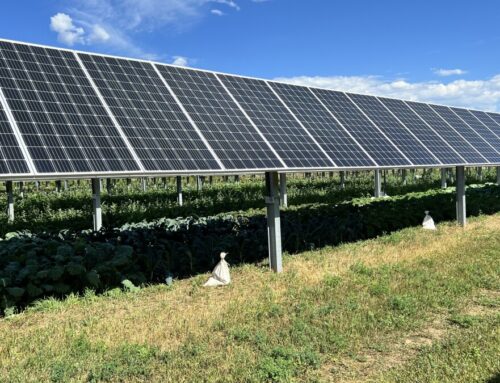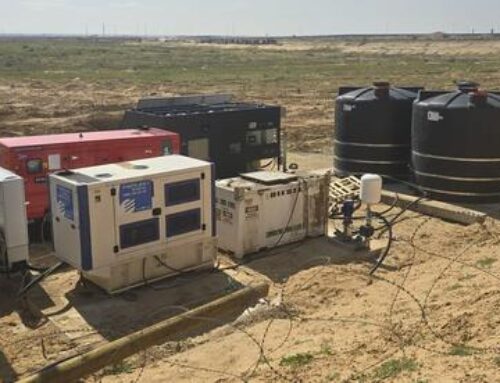Trump administration pauses funds for renewable energy projects in AZ
April 5, 2025
The Trump Administration has put on hold a nearly $500 million federal grant to a Benson power cooperative and a $1.8 billion loan guarantee to Phoenix utility giant Arizona Public Service Co. as it weighs clawing back financing of renewable energy projects, which it generally philosophically opposes.
The $485 million grant to Arizona Electric Power Cooperative Inc. from the U.S. Department of Agriculture would defray much of the nonprofit utility’s entire $2.5 billion tab for building two solar energy generating and battery storage facilities, one in Cochise County and another in Pinal County.
The power will be generated by nonprofit, rural electric cooperatives and by public power electric utilities. When the projects are built — which company officials say will happen regardless of whether the grant survives — they’ll generate about 730 megawatts of solar energy and 2,940 megawatt-hours of battery storage capacity. The battery storage keeps some of the sun’s energy taken in by the solar plant for use during nighttime hours when the sun isn’t around to provide energy.
People are also reading…
The grant “will enable us to make major new investments in renewable power, which will modernize our fleet, substantially lower emissions and help keep costs stable for years to come,” said Patrick Ledger, CEO and executive vice president for the Benson-based power company, commonly known as AEPCO.
AEPCO’s parent organization, Arizona G&T Cooperatives, last year was also awarded a $56 million federal grant under a separate USDA program for three additional battery storage facilities, including one in Sahuarita, to be built by three electric co-ops. That grant money was also put on hold by the Trump Administration but the co-ops have already built the three battery storage plants.
The loan guarantee to APS — which has been only conditionally approved so far — would help pay for a number of renewable projects. The utility, asked to identify them, specified only one — its Agave Battery Energy Storage System Phase 1, a 150-megawatt project, to be located next to an existing solar power site in Maricopa County and expected to go online by 2026. The other projects will be chosen separately through the utility’s standard procurement process. The loan would be made by the U.S. Department of Energy.
The actual funding of these projects has been on hold since Jan. 20 by the Trump Administration as part of a delay in spending money appropriated by the 2022 Inflation Reduction Act. That act appropriated the funds now planned for the AEPCO grant and the APS loan guarantee. In late March, the administration sent out signals it may be willing to release the $485 million soon to AEPCO. But the fate of the $1.8 billion APS loan guarantee remains an open question.
The projects funded by the $485 million grant to AEPCO are aimed at stabilizing electricity costs for rural customers in Arizona and three other Southwestern states — customers whose incomes are generally lower than national average income, said Ledger. The Pinal County project also has a broader purpose: Serving as an alternative power source to power from Hoover and Glen Canyon dams in the event their water levels continue to decline, reducing electricity output. It’s slated to be built somewhere northwest of Picacho Peak.
Provided by Arizona Electric Power Cooperative
The lower electric costs from the two solar plants would benefit a total of 46 separate entities, including electric co-ops, cities, electrical districts, agricultural districts and tribes, Ledger said. Among the beneficiaries would be the Trico Electric Co-op, which serves customers in Marana, Green Valley, Vail, SaddleBrooke, Sahuarita and on Mount Lemmon and other suburban areas surrounding Tucson.
The Benson-area plant will produce enough electricity to power about 55,000 homes. But because a large number of utilities will get some of its power, AEPCO estimates about 750,000 people over a large geographic area will receive some power from the plant, Ledger said.
“What we’re trying to achieve here is the emissions reduction goal” set by the Biden Administration for a program called New Empowering Rural America, he said. That USDA effort aimed to help rural Americans transition into renewable energy sources such as solar from the coal, oil and natural gas-based sources they’ve historically depended on.
The solar plants would reduce AEPCO’s carbon-based emissions by 70%, compared to its plants’ 2014 emissions, Ledger said.
If the grant doesn’t happen, the projects’ cost to customers would be higher, he said. The Benson-area project should be online for commercial use by the end of 2025, and the Pinal County project should be serving commercial customers by the end of 2027, he said.
The utility received a letter from the Agriculture Department in December committing to the grant.
As for the APS loan guarantee, the DOE announced its conditional approval on Jan. 7.
The loan guarantee would help finance APS’ investments into several new or upgraded transmission projects, renewable power generation, and grid-integrated energy storage systems, DOE said then. APS aims to invest in a broad range of new infrastructure technologies to meet expected demand growth while lowering its emissions and saving its 1.4 million customers money on their electricity bills, it said.
Consistent with Environmental Protection Agency regulations, the renewable energy generation financed by the loan guarantee would support replacing power now generated by coal-fired plants that the utility plans to retire, DOE said.
The loan in question would support APS’ publicly stated goals of delivering affordable 100% clean and carbon-free electricity by 2050, and its interim goals of achieving a resource mix of 65% clean energy, with 45% of its generation portfolio coming from renewable energy by 2030, DOE said. The loan would also support APS’ plan to exit from coal-fired generation in 2031, it said.
But while the conditional commitment indicates DOE’s intent to provide a loan guarantee, the agency and APS “must satisfy certain technical, legal, environmental, and financial conditions before the department enters into definitive financing documents and funds the loan,” DOE said.
Provided by Arizona Electric Power Cooperative
Then, on Inauguration Day Jan. 20, the White House issued an executive order that “paused” all federal outlays for projects such as these that are financed by the Inflation Reduction Act. The freeze was announced in a section titled, “Terminating the Green New Deal.”
The order said all agencies planning to spend money appropriated by that act must first review their “processes, policies and programs for issuing grants, loans, contracts or any other financial disbursements” to insure they’re consistent with federal law and policies outlined in the new executive order.
The policies mentioned in the order don’t explicitly urge a halt to spending on renewable projects. But they clearly emphasize exploration and production of energy resources on federal lands and give preference to “oil, natural gas, coal, hydropower, biofuels, critical mineral, and nuclear energy resources.”
On March 25, the Agriculture Department announced it would release federal grants under the New Empowering Rural America Program, but with an important caveat. Grant recipients such as AEPCO were told to “review and voluntarily revise” their projects to align with Trump’s Jan. 20 executive order. USDA called on grant recipients to “refocus” projects on expanding energy production while eliminating diversity, equity and inclusion policies and “climate mandates” embedded in earlier proposals.
“We’re ensuring these investments support U.S. energy production while putting America’s farmers, ranchers, and rural businesses first,” U.S. Agriculture Secretary Brooke Rollins said in announcing the changes.
However, on March 26, the department wrote grant applicants a letter that seemed to offer them a way to get funded without changing their grants’ basic goals. The department posted on one of its websites that applicants had 30 days to respond with whether they wish to change their applications. If they don’t respond, “disbursements” of funds will resume after 30 days, and if they do respond to confirm they want no changes, “processing on their projects will resume immediately,” the USDA said.
DOE, asked about the status of its conditional loan approval for APS, would offer only a general comment, saying it is “reviewing all programs and complying with all laws and relevant court orders to ensure that projects funded by taxpayer dollars meet the Trump Administration’s goals of expanding energy access, improving energy reliability, and reducing energy bills for homes and businesses.”
AEPCO CEO Ledger said the company’s grant application may change “to some degree” because of Rollins’ comments, “but the large solar and battery projects will remain the centerpiece of the plan because they make economic sense and help diversify our portfolio, which reduces risk and improves reliability.”
He also said, “We will not include additional coal fired facilities in the plan.”
Overall, “we are a proponent of the ‘all of the above’ energy policy. We look at things from an economic and practical perspective to determine what is in the best interest of our cooperative and public power utility membership, and they participate democratically in our resource development decisions,” Ledger said. “In addition to the solar and battery, we continue to operate our existing fleet and we are building small efficient natural gas peaking units, so we think our overall approach is consistent with the objectives of the new administration.”
Amanda Ormond, a Flagstaff-based consultant on energy issues, said she is optimistic the grant to AEPCO will go through but she is less certain about the APS grant, not least because it was rated conditional even before the Trump Administration put it on hold.
Provided by Arizona Electric Power Cooperative
Of the AEPCO solar-based plan, she said she believes it meets many of the criteria the Trump Administration uses to review projects. “The administration wants the U.S. to achieve energy dominance, and building renewable energy puts technology on the ground where it’s needed,” she said. “They want energy to be cost effective, and renewable energy is the lowest cost energy available to electric utilities.”
Arizona has experienced such growth in electricity demand that the renewable generation is badly needed, said Ormond, who ran the Arizona State Energy Office during the administrations of Republican Govs. Jane Hull and Fife Symington in the 1990s and early 2000s. “The Trump Administration has no basis to call back this money.”
Contact Tony Davis at 520-349-0350 or tdavis@tucson.com. Follow Davis on Twitter@tonydavis987.
Search
RECENT PRESS RELEASES
Related Post




